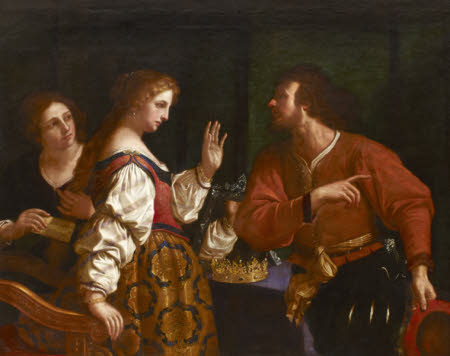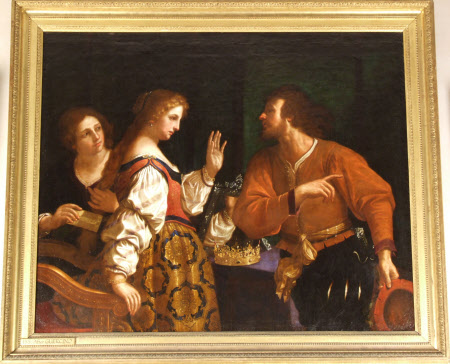Queen Semiramis of Assyria (9th century BC) at her Toilet receiving a Report of the Revolt of her Troops (after Guercino)
possibly Bartolomeo Gennari (1594 - 1661)
Category
Art / Oil paintings
Date
1600 - 1699
Materials
Oil on canvas
Measurements
1295 x 1575 mm (51 x 62 in)
Order this imageCollection
Petworth House and Park, West Sussex
NT 485058
Caption
As told by the Roman moralist Valerius Maximus in his Facta et Dicta Memorabilia, Queen Semiramis, one of the mythical founders of the Assyrian empire of Nineveh, is interrupted while dressing, by a messenger telling her of a Babylonian rebellion. Her hair is undone but she takes a solemn oath to abandon her toilette until peace is restored. Another version is at Hatchlands (Cobbe Collection [353]; NT 1165964)
Summary
Oil painting on canvas, Queen Semiramis of Assyria (9th century BC) at her Toilet receiving a Report of the Revolt of her Troops, possibly Bartolommeo Gennari (1594-1661), after and studio of Guercino (Cento 1591 – Bologna 1666), 17th century. The beautiful Queen, one of the mythical founders of the Assyrian empire of Nineveh, is seen standing on the left, profile right, with her left hand raised, wearing a red bodice, white sleeves, and a black and gold skirt. Behind her a maid, is holding a comb. On the right, a messenger, profile left, in deep cinnamon, holding a red hat, is pointing right with his right hand. As told by the Roman moralist, Valerius Maximus (fl. AD 14) in Facta et Dicta Memorabilia IX:4, Semiramis was the daughter of the fish-goddess Derceto, by a Syrian youth who was abandoned by her mother in the wild when an infant and kept miraculously alive by doves. Named after the family of Simmas, chief shepherd of the royal herds who discovered her, here she is interrupted at her toilet by a shepherd announcing the revolt of Babylon. According to the story, on hearing the news she runs out, hair still undone, to put matters to right. Other repetitions of this composition, one of which was commissioned by Cardinal Federigo Cornaro (1579 - 1653) by Guercino in the Cobbe Collection (353) at Hatchlands (NT 1165964) and ex-Northbrook Collection (which in addition has unfinished passages) exist and other earlier different renditions, of 1624 and around 1627-8, are in the Museum of Fine Arts, Boston (once owned by King Charles II) and previously in the Dresden Gallery (destroyed in Second World War) respectively.
Provenance
In the collection of the 3rd Earl of Egremont (1751-1837) by 1835. By descent to the current Lord Egremont. On loan from the Egremont Private Collection
Credit line
Petworth House, The Egremont Collection
Makers and roles
possibly Bartolomeo Gennari (1594 - 1661), artist after Guercino (Cento 1591 – Bologna 1666) , artist
References
Clerics and Connoisseurs: the Rev. Matthew Pilkington, the Cobbe Family and the Fortunes of an Irish Art Collection through Three Centuries (ed. Alastair Laing), The Iveagh Bequest, Kenwood, London, English Heritage, 19th October 2001 - 27 January 2002, 57b Mahon 1949 D. Mahon, 'Guercino's Paintings of Semiranis', The Art Bulletin, vol. 31, 1949, pp.217-23

